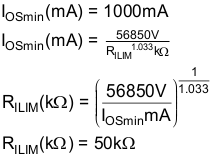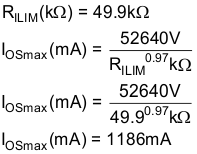ZHCSHI4D January 2018 – December 2019 TPS25221
PRODUCTION DATA.
- 1 特性
- 2 应用
- 3 说明
- 4 修订历史记录
- 5 Device Comparison Table
- 6 Pin Configuration and Functions
- 7 Specifications
- 8 Parameter Measurement Information
- 9 Detailed Description
- 10Application and Implementation
- 11Power Supply Recommendations
- 12Layout
- 13器件和文档支持
- 14机械、封装和可订购信息
封装选项
机械数据 (封装 | 引脚)
散热焊盘机械数据 (封装 | 引脚)
- DRV|6
订购信息
10.2.1.2.1 Designing Above a Minimum Current Limit
Some applications require that current limiting cannot occur below a certain threshold. For this example, assume that 1 A must be delivered to the load so that the minimum desired current-limit threshold is 1000 mA. Use the IOS equations and Figure 24 to select RILIM.
Equation 3. 

Select the closest 1% resistor less than the calculated value: RILIM = 49.9 kΩ. This sets the minimum current-limit threshold at 1 A . Use the IOS equations, Figure 24, and the previously calculated value for RILIM to calculate the maximum resulting current-limit threshold.
Equation 4. 

The resulting maximum current-limit threshold is 1186 mA with a 49.9 kΩ resistor.